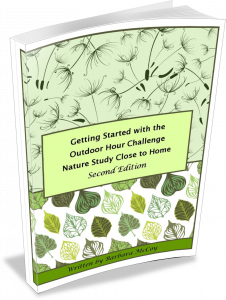Outdoor Hour Challenge #5
Making a List
1. Have you decided on a focus area yet?
If you have a focus already, turn to the table of contents in the Handbook of Nature Study and skim down to your area of focus. Look down the list of subjects covered in your area. Highlight or underline those items listed that you think you will encounter during the next five to seven weeks. For example if your area of focus is garden flowers, skim down the list and see if you recognize any flower names that you have in your backyard or area. I actually see ten flowers that our family may come in contact with in our region. Pick one item in your focus area to study, turn to those pages, and read to your child about that subject. At the end of each section, there are observation ideas for each subject and these observation suggestions will be the parent’s reading assignment this week.(see below) As you find things in your focus area, keep a running list in the front or back of your nature journal of those items.
Reading Assignment for parents: Read the observation suggestions in the Handbook of Nature Study for the item you chose to read about with your child. Keep these ideas in mind as you have your outdoor time this week. For example, if you are focusing on garden flowers and you are going to read to your child about tulips, turn to the end of the section on tulips and read Lesson 151 which includes eight suggestions for observation. Keep these ideas in mind as you head out for your nature walk.
2. During your 10-15 minute walk, use your senses to not only observe but to hear the sounds of your surroundings.
“ …the mother must not miss this opportunity of being outdoors to train the children to have seeing eyes, hearing ears and seeds of truth deposited into their minds to grow and blossom on their own in the secret chambers of their imaginations”
“No reading aloud or storytelling–in fact, there should be as little talking from her (mother) as possible, and what little there is should have a definite purpose.” Charlotte Mason volume one, page 45
3. Follow up with a discussion. Did you see anything new to add to your list of focus items? Did you complete any of the suggested observations? Do you need to do any further research to answer questions?
4. Give an opportunity for a nature journal entry. Try to encourage a simple drawing, a label, and a date. Pull out the previous challenges and review the alternatives for younger children.
The main idea of this challenge is to start a list of things you find within your focus area. You can use paper clips to fasten a list into the front of your nature journal. The list can be removed when you change your focus and it can be taped or glued into your nature journal on any page you choose.
The list can be simply the names of the items or you can add the dates you observed them and the location if you want to be more thorough. Sometimes my whole nature journal entry is just a list of things that I see on a particular outing.
The beauty of a nature journal is that it is yours to do with as you want to. I hope to give you a lot of ideas that you can choose from over the coming challenges.
This challenge is found in the Getting Started ebook which is included in every level of membership. The ebook provides the challenge as shown above as well as custom notebook pages for your follow up nature journal if desired.









































